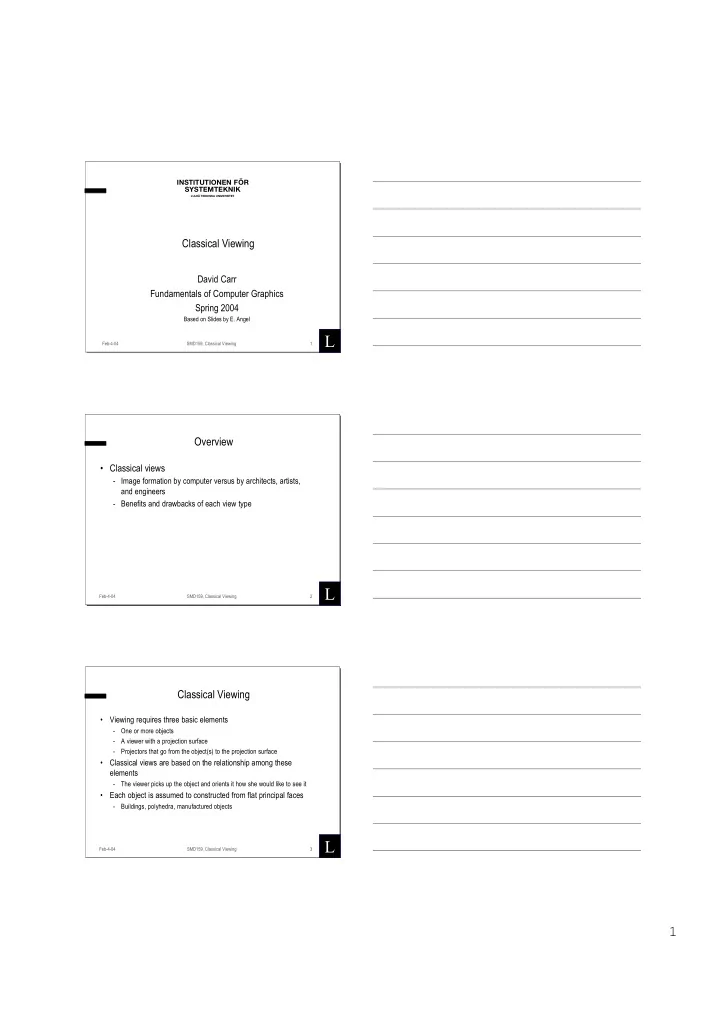

INSTITUTIONEN FÖR SYSTEMTEKNIK LULEÅ TEKNISKA UNIVERSITET Classical Viewing David Carr Fundamentals of Computer Graphics Spring 2004 Based on Slides by E. Angel 1 L Feb-4-04 SMD159, Classical Viewing Overview • Classical views - Image formation by computer versus by architects, artists, and engineers - Benefits and drawbacks of each view type 2 L Feb-4-04 SMD159, Classical Viewing Classical Viewing • Viewing requires three basic elements - One or more objects - A viewer with a projection surface - Projectors that go from the object(s) to the projection surface • Classical views are based on the relationship among these elements - The viewer picks up the object and orients it how she would like to see it • Each object is assumed to constructed from flat principal faces - Buildings, polyhedra, manufactured objects 3 L Feb-4-04 SMD159, Classical Viewing 1
Planar Geometric Projections • Standard projections project onto a plane • Projectors are lines that either - converge at a center of projection - are parallel • Such projections preserve lines - but not necessarily angles • Non-planar projections are needed for applications such as map construction 4 L Feb-4-04 SMD159, Classical Viewing Classical Projections 5 L Feb-4-04 SMD159, Classical Viewing Perspective versus Parallel • Computer graphics: - Treats all projections uniformly - Implements them with a single pipeline • Classical viewing developed different techniques for drawing each type of projection • Fundamental distinction is between: - Parallel and perspective viewing - Mathematically parallel viewing is the limit of perspective viewing 6 L Feb-4-04 SMD159, Classical Viewing 2
Taxonomy of Planar Geometric Projections planar geometric projections parallel perspective 1 point 2 point 3 point multiview axonometric oblique orthographic isometric dimetric trimetric 7 L Feb-4-04 SMD159, Classical Viewing Perspective Projection 8 L Feb-4-04 SMD159, Classical Viewing Parallel Projection 9 L Feb-4-04 SMD159, Classical Viewing 3
Orthographic Projection • Projectors are orthogonal to projection surface 10 L Feb-4-04 SMD159, Classical Viewing Multi-view Orthographic Projection • Projection plane parallel to principal face • Usually form front, top, side views isometric (not multi-view orthographic view) front in CAD and architecture, we often display three multi-views plus isometric side top 11 L Feb-4-04 SMD159, Classical Viewing Advantages and Disadvantages • Preserves both distances and angles - Shapes preserved - Can be used for measurements + Building plans + Manuals • Cannot see what object really looks like because many surfaces hidden from view - Often we add the isometric 12 L Feb-4-04 SMD159, Classical Viewing 4
Axonometric Projections • Allow projection plane to move relative to object classify by how many angles of a corner of a projected cube are the same q 1 none: trimetric q 2 q 3 two: dimetric three: isometric 13 L Feb-4-04 SMD159, Classical Viewing Types of Axonometric Projections 14 L Feb-4-04 SMD159, Classical Viewing Advantages and Disadvantages • Lines are scaled (foreshortened) but can find scaling factors • Lines preserved but angles are not - Projection of a circle in a plane not parallel to the projection plane is an ellipse • Can see three principal faces of a box-like object • Some optical illusions possible - Parallel lines appear to diverge • Does not look real because far objects are scaled the same as near objects • Used in CAD applications 15 L Feb-4-04 SMD159, Classical Viewing 5
Oblique Projection • Arbitrary relationship between projectors and projection plane 16 L Feb-4-04 SMD159, Classical Viewing Advantages and Disadvantages • Can pick the angles to emphasize a particular face - Architecture: plan oblique, elevation oblique • Angles in faces parallel to projection plane are preserved while we can still see “around” side • In physical world, cannot create with simple camera; possible with bellows camera or special lens (architectural) 17 L Feb-4-04 SMD159, Classical Viewing Perspective Projection • Projectors coverge at center of projection 18 L Feb-4-04 SMD159, Classical Viewing 6
Vanishing Points • Parallel lines (not parallel to the projection plan) on the object converge at a single point in the projection (the vanishing point) • Drawing simple perspectives by hand uses these vanishing point(s) vanishing point 19 L Feb-4-04 SMD159, Classical Viewing Three-Point Perspective • No principal face parallel to projection plane • Three vanishing points for cube 20 L Feb-4-04 SMD159, Classical Viewing Two-Point Perspective • On principal direction parallel to projection plane • Two vanishing points for cube 21 L Feb-4-04 SMD159, Classical Viewing 7
One-Point Perspective • One principal face parallel to projection plane • One vanishing point for cube 22 L Feb-4-04 SMD159, Classical Viewing Advantages and Disadvantages • Objects further from viewer are projected smaller than the same sized objects closer to the viewer (diminuition) - Looks realistic • Equal distances along a line are not projected into equal distances (nonuniform foreshortening) • Angles preserved only in planes parallel to the projection plane • More difficult to construct by hand than parallel projections (but not more difficult by computer) 23 L Feb-4-04 SMD159, Classical Viewing Questions? 24 L Feb-4-04 SMD159, Classical Viewing 8
Recommend
More recommend